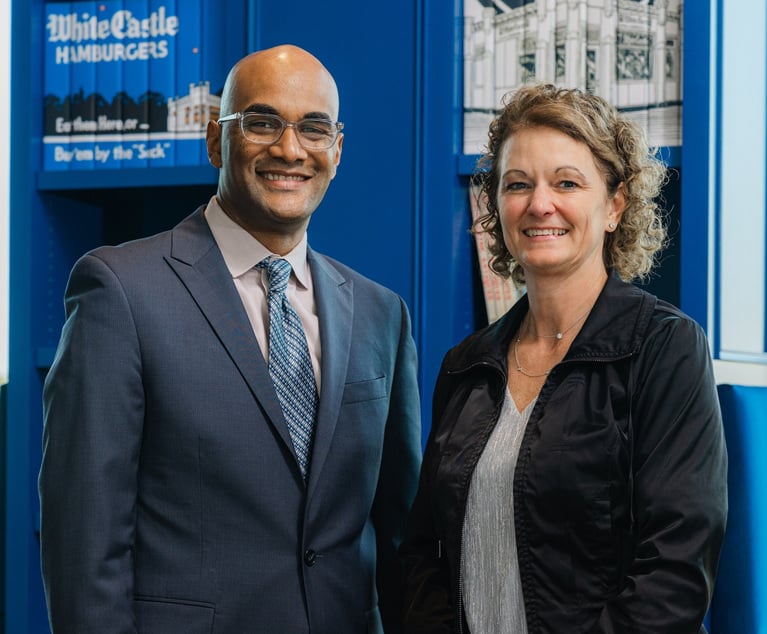How to make a phone call
I’ve devoted columns to best practices for using new media tools such as LinkedIn, Legal OnRamp and even Twitter. However, I remain adamant in my opinion that your most important career development activities will take place in-person.
June 16, 2011 at 12:02 PM
5 minute read
The original version of this story was published on Law.com
I've devoted columns to best practices for using new media tools such as LinkedIn, Legal OnRamp and even Twitter. However, I remain adamant in my opinion that your most important career development activities will take place in-person. For building your personal brand externally, nothing beats a high quality conference. This explains why InsideCounsel's annual SuperConference was such a smash hit again last month. I've also written columns on the “how to” elements of conference networking.
Until now, however, I've neglected to focus on the most important device ever created to help advance your career— the telephone. Making a high quality phone call is the best way to make your online and in-person activity pay off. It's called effective follow-up. And it may be a dying art.
I wish to thank a SuperConference attendee for focusing my attention on the phone. A senior in-house counsel told me that someone on her staff replied to a question she left, on a voice message, with a text message seeking clarification of the voice message. We mused about the generational shift away from using the phone for its original purpose.
You may think the phone is intrusive. That's usually an excuse for fear. Get over it. Making a good phone call remains a critical element for moving people to action, whether the context is job hunting, business development or moving the ball forward on an internal corporate objective.
Think back to the early days of email use as a business tool. Recall when it felt special to receive an email. When crafting a business email 20 years ago, you would take care to send a high quality message. This was well before the floodgates opened and everyone started digesting hundreds of emails every day via smartphones. In fact, you could really stand out by sending a good email.
I believe that email and phone calls have now reversed roles. To reach someone immediately, to firm up logistics, to relay some factual piece of information and for many more day-to-day aspects of simply getting business done, email or text is clearly the prevailing medium for communicating. So, if you want to make an impact, if you want to convey a meaningful introduction, if you want to persuade someone to action—use the phone. Do so in a way that will make the recipient of that call feel special. If possible, make it an interesting experience, just as email was fun 20 years ago. Sure, a phone call lacks the novelty factor, but since people receive fewer calls, an opportunity exists to really create a positive impression. As with the early days of email, the best calls will be the ones that are thoughtful and articulate.
I could offer numerous examples of good phone calls in various career related situations, but I'll focus on the hardest moment for readers who may be in active job search mode. The phone call asking for an interview or networking meeting is indeed a difficult call to make. Rejection is a likely outcome and it does take quite a bit of backbone to make these calls. Yet, it's a critical follow-up step after receiving a referral, meeting someone at a conference, or sending out a resume.
In terms of tone, you want to be confident but casual. Too much energy will convey a telemarketing vibe and turn off most businesspeople. A timid or apologetic tone is even worse. Never start a call with anything similar to, “I'm sorry to bother you, but…” You might be surprised by how many calls I receive that start exactly that way.
In terms of message, be prepared. Starting a call with “how are you?” and small talk is fine when calling certain people who you know well. In this context, however, get to the core of your message right away. If you are calling a general counsel, state how you can help that person by doing one of three things (pick one): 1. Save her time, 2. Save her company money or 3. Help her achieve a business objective that she has mentioned publicly (online, in an interview, at a conference, etc.). My favorite is No.3 when possible. It shows that you've done your homework, and this approach is most likely to catch a general counsel's interest. Be prepared with one or two bullet points to support your claim.
When the general counsel says either “we are not hiring” or “the opening we have right now is for someone with different/less/more experience,” I urge you to push back in a way that you can't do via email. Show some lawyerly courage and ask for 20 minutes over coffee anyway. Say you understand there may not be an opening right now, but that you want to make a long-term networking connection and would be grateful if she says “yes.” Make that request. Good things will happen; some GCs may see you, and others will have referral suggestions. Most will say “no” to a meeting, and you have to accept that. Be gracious. If you have stood out, however, and if you have made a good impression, then you can build on that in future communications.
Beyond the job search context, there are unlimited examples of when a phone call is far superior to an email. Just a few: calibrating on a new project, seeking or offering advice, discussing a colleague, etc. If a matter is urgent and the other person is easier to reach via email, then use email. Otherwise, I offer a simple rule of thumb. If something is truly important, then pick up the phone to talk about it.
This content has been archived. It is available through our partners, LexisNexis® and Bloomberg Law.
To view this content, please continue to their sites.
Not a Lexis Subscriber?
Subscribe Now
Not a Bloomberg Law Subscriber?
Subscribe Now
NOT FOR REPRINT
© 2025 ALM Global, LLC, All Rights Reserved. Request academic re-use from www.copyright.com. All other uses, submit a request to [email protected]. For more information visit Asset & Logo Licensing.
You Might Like
View All
White Castle GC Becomes Chain's First President From Outside Family

Beyond the Title: Developing a Personal Brand as General Counsel
Trending Stories
- 1Courts, Lawyers Press On With Business as SoCal Wildfires Rage
- 2Florida, a Political Epicenter, Is the Site of Brownstein Hyatt's 13th Office
- 3Law Firms Close Southern California Offices Amid Devastating Wildfires
- 4Lawsuit alleges racial and gender discrimination led to an Air Force contractor's death at California airfield
- 5Holland & Knight Picks Up 8 Private Wealth Lawyers in Los Angeles
Who Got The Work
Michael G. Bongiorno, Andrew Scott Dulberg and Elizabeth E. Driscoll from Wilmer Cutler Pickering Hale and Dorr have stepped in to represent Symbotic Inc., an A.I.-enabled technology platform that focuses on increasing supply chain efficiency, and other defendants in a pending shareholder derivative lawsuit. The case, filed Oct. 2 in Massachusetts District Court by the Brown Law Firm on behalf of Stephen Austen, accuses certain officers and directors of misleading investors in regard to Symbotic's potential for margin growth by failing to disclose that the company was not equipped to timely deploy its systems or manage expenses through project delays. The case, assigned to U.S. District Judge Nathaniel M. Gorton, is 1:24-cv-12522, Austen v. Cohen et al.
Who Got The Work
Edmund Polubinski and Marie Killmond of Davis Polk & Wardwell have entered appearances for data platform software development company MongoDB and other defendants in a pending shareholder derivative lawsuit. The action, filed Oct. 7 in New York Southern District Court by the Brown Law Firm, accuses the company's directors and/or officers of falsely expressing confidence in the company’s restructuring of its sales incentive plan and downplaying the severity of decreases in its upfront commitments. The case is 1:24-cv-07594, Roy v. Ittycheria et al.
Who Got The Work
Amy O. Bruchs and Kurt F. Ellison of Michael Best & Friedrich have entered appearances for Epic Systems Corp. in a pending employment discrimination lawsuit. The suit was filed Sept. 7 in Wisconsin Western District Court by Levine Eisberner LLC and Siri & Glimstad on behalf of a project manager who claims that he was wrongfully terminated after applying for a religious exemption to the defendant's COVID-19 vaccine mandate. The case, assigned to U.S. Magistrate Judge Anita Marie Boor, is 3:24-cv-00630, Secker, Nathan v. Epic Systems Corporation.
Who Got The Work
David X. Sullivan, Thomas J. Finn and Gregory A. Hall from McCarter & English have entered appearances for Sunrun Installation Services in a pending civil rights lawsuit. The complaint was filed Sept. 4 in Connecticut District Court by attorney Robert M. Berke on behalf of former employee George Edward Steins, who was arrested and charged with employing an unregistered home improvement salesperson. The complaint alleges that had Sunrun informed the Connecticut Department of Consumer Protection that the plaintiff's employment had ended in 2017 and that he no longer held Sunrun's home improvement contractor license, he would not have been hit with charges, which were dismissed in May 2024. The case, assigned to U.S. District Judge Jeffrey A. Meyer, is 3:24-cv-01423, Steins v. Sunrun, Inc. et al.
Who Got The Work
Greenberg Traurig shareholder Joshua L. Raskin has entered an appearance for boohoo.com UK Ltd. in a pending patent infringement lawsuit. The suit, filed Sept. 3 in Texas Eastern District Court by Rozier Hardt McDonough on behalf of Alto Dynamics, asserts five patents related to an online shopping platform. The case, assigned to U.S. District Judge Rodney Gilstrap, is 2:24-cv-00719, Alto Dynamics, LLC v. boohoo.com UK Limited.
Featured Firms
Law Offices of Gary Martin Hays & Associates, P.C.
(470) 294-1674
Law Offices of Mark E. Salomone
(857) 444-6468
Smith & Hassler
(713) 739-1250








